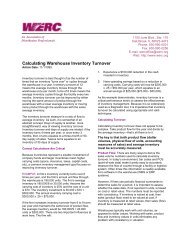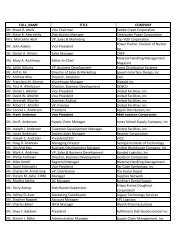Optimizing Inventory Management - WERC
Optimizing Inventory Management - WERC
Optimizing Inventory Management - WERC
Create successful ePaper yourself
Turn your PDF publications into a flip-book with our unique Google optimized e-Paper software.
8<br />
<strong>Optimizing</strong> <strong>Inventory</strong> <strong>Management</strong> continued from page 3<br />
are shared by Bursa and based on the experiences of<br />
Logility customers include:<br />
Freeing millions of dollars of working capital trapped<br />
in excess inventory<br />
Meeting required service levels during business<br />
cycle upswings without creating excess inventory<br />
Managing better during difficult economic<br />
conditions, having the ability to bring down<br />
inventory more quickly to a normalized level and<br />
able to more quickly respond to increases in demand<br />
during a recovery<br />
Understanding the true cost required to increase<br />
service levels Improve inventory turns (which<br />
increases competitiveness, noticed by analysts)<br />
Reducing costly obsolescence, stock-outs, and<br />
expediting<br />
Handling changing demand without creating<br />
unnecessarily large inventory buffers<br />
Anticipating time-phased demand changes caused<br />
by seasonality and business cycles<br />
Creating more confident inventory decisions based<br />
on facts rather than opinions<br />
Developing more successful S&OP processes with<br />
parties mutually agreeing on best practices<br />
Having a common view/understanding of the supply<br />
chain (literally everyone has the same “map”)<br />
Extending smart inventory policies to stock held at<br />
customer locations and/or supplier DCs (better<br />
demand sensing, better lead time control)<br />
“An IO solution should offer opportunities for supply<br />
chain professionals to understand the causes of inventory,<br />
accept or reject recommendations, and build trust<br />
in fact-based decision-making,” explains Bursa. “As this<br />
trust is built/earned, we will see further expansion of IO<br />
into DCs.”<br />
Ellis and IDC Manufacturing Insights believe that<br />
IO technology will eventually morph into a broader<br />
category consisting of supply chain related business<br />
analytics and decision-support applications. In addition<br />
to IO, these applications would include: strategic supply<br />
chain network design and simulation; sourcing and<br />
procurement spend management analytics; and analytics<br />
that integrate supply demand sensing, real-time<br />
execution information, and global transportation and<br />
logistics landed cost information.<br />
2010 © Copyright, <strong>WERC</strong>. All rights reserved.<br />
Simon D. Ellis, IDC Manufacturing Insights, www.idc-mi.com<br />
R. Michael Donovan, R. Michael Donovan & Co., Inc.<br />
www.rmdonovan.com<br />
Karin Bursa, Logility, www.logility.com<br />
/ September–October 2010<br />
Justifying the IO<br />
technology solution<br />
<strong>Inventory</strong> optimization (IO) is a tool that is managed centrally<br />
by a company’s inventory planning department, rather<br />
than the warehouse, maintains Simon D. Ellis, practice director,<br />
supply chain strategies, IDC Manufacturing Insights, Framingham,<br />
Mass. “From a warehousing perspective, the operation of<br />
the inventory optimization tool will be transparent,” he<br />
explains.<br />
The cost of an IO implementation is quite variable, says<br />
Ellis, “with vendors in the space pricing quite differently.”<br />
Although the cost of software has been coming down, a typical<br />
implementation should be expected to be in the $300,000 to<br />
$600,000 range for software, with a project timeline of<br />
typically six to nine months, he offers. Implementation costs<br />
also will be variable, and are dependent upon the use of outsourced<br />
consulting resources and the size/duration of any<br />
internal resources. “But these should be in the same range as<br />
software costs,” according to Ellis.<br />
The benefits of an IO implementation can be significant.<br />
“The magnitude of actual savings will depend upon the preimplementation<br />
level of inventory control and the magnitude<br />
of supply network complexity,’ notes Ellis, “but it is not unusual<br />
for a global supply chain to see inventory levels reduced by as<br />
much as 15 to 25 percent.” While actual costs and savings for<br />
specific implementations are proprietary, he reports that the<br />
manufacturing companies surveyed indicated that a one- to<br />
two-year payback is not unusual, with a discounted cash flow<br />
ROI above the 50 percent range.<br />
“In the current economic climate,” he concludes, “the investment<br />
in inventory optimization is compelling.”<br />
Meanwhile, when launching a search for an IO tool, Karin<br />
Bursa, vice president, marketing, Logility, Atlanta, recommends<br />
gathering answers to the following:<br />
Is this solution truly capable of multi-echelon IO (MEIO)?<br />
Does it provide the ability to optimize more than one<br />
location or stage (the MEIO of IO) of the supply chain<br />
produces significantly greater savings and service level<br />
improvements?<br />
Does the IO software assign monetary as well as volumetric<br />
values to all aspects of the supply chain so that economic<br />
impacts of different scenarios at various stages are<br />
accurately predicted?<br />
Does the solution include time-phased capabilities to<br />
optimize inventory with a cyclical demand signal (such<br />
as seasonality)?<br />
With the complex mathematical calculations involved, not<br />
all IO tools operate as well (or at all) above a certain number<br />
of SKUs. Can this solution handle growing complexity as we<br />
roll it out?<br />
Does the IO tool monitor targets on an exception basis, so<br />
planners can spend more time on problem solving and<br />
high-value activities?







